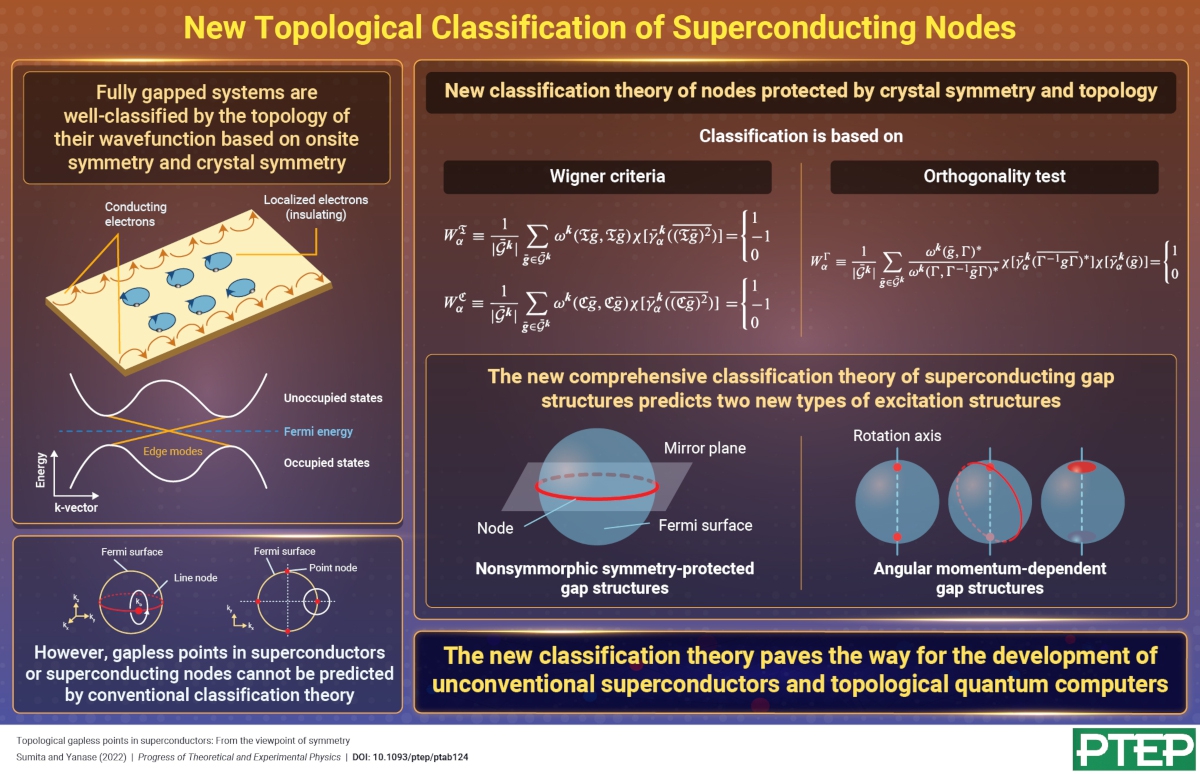New Classification Theory for Topological Gapless Superconducting Nodes
© The Physical Society of Japan
This article is on
Topological gapless points in superconductors: From the viewpoint of symmetry
(PTEP Editors' Choice)
Prog. Theor. Exp. Phys.
https://doi.org/10.1093/ptep/ptab124, .
A new classification theory on topological superconducting gap nodes predicts two new gap structures emerging from a nonsymmorphic crystal symmetry and angular momentum.

Topological phases of matter, such as topological insulators, semimetals, and superconductors, have garnered much attention in condensed matter physics. These are strange materials characterized by the presence of conduction states on the surface while the bulk remains insulating. Moreover, the surface states are protected by certain symmetries against physical deformations or defects.
It turns out that such systems can be classified by a “topological invariant” or a topological number such that two systems with the same topological number are equivalent. The topological invariant is classified by the symmetry and dimensionality of the system and is well-defined for gapped Hamiltonian systems. A well-known classification scheme is based on onsite symmetries, such as time-reversal symmetry, particle-hole symmetry, and chiral symmetry. However, recent schemes involve both crystal symmetry and onsite symmetry.
Interestingly, topological superconductors often have gapless points called “superconducting nodes” that are characterized by topological invariants, even though topology for the wavefunction can only be defined for gapped Hamiltonians. While there exist some classification theories for the superconducting order parameter predicting such nodes, they are sometimes incompatible with the actual superconducting gap structure and do not account for space group symmetry and higher-spin states.
In this paper, we present a new classification theory for superconducting nodes to resolve these two problems. We constructed this theory based on arguments from group theory and topology. An earlier topological classification theory focused on the d-dimensional Brillouin zone (BZ). However, since a band gap cannot exist in a whole d-dimensional BZ in nodal superconductors, we instead considered a p-dimensional (p < d) sphere surrounding nodes in the BZ.
We fixed a specific k point in the BZ and then developed the classification theory on the high-symmetry points using the Wigner criteria and the orthogonality test. Our results predicted two new types of excitation structures, i.e., unconventional superconducting nodes protected by crystal symmetry and topology.
By performing classification on high-symmetry planes, we predicted nontrivial gap structures appearing from nonsymmorphic space group symmetry, which can be decomposed into a product of non-primitive lattice translation and a point group operation. Meanwhile, performing classification on high-symmetry lines helped predict nontrivial gap structures dependent on the angular momentum of the normal Bloch state.
Because these classification structures are determined only by symmetry, they can be universally applied to many candidate superconductors, potentially leading to the discovery of superconductors hosting unconventional nodes.
Topological gapless points in superconductors: From the viewpoint of symmetry
(PTEP Editors' Choice)
Prog. Theor. Exp. Phys.
https://doi.org/10.1093/ptep/ptab124,
.
Share this topic
Fields
Related Articles
-
Fractional Vortex Array with Nontrivial Topological Structure Realized at Twin Boundary of Nematic Superconductor
Superconductivity
2025-3-24
Analysis of the two-component Ginzburg-Landau theory suggests that a conventional vortex is transformed into two fractional vortices with the topological nature of core-down and core-up merons at the twin boundary of a nematic superconductor.
-
Exploring the Vibrant Interplay of Machine Learning and Physics
Cross-disciplinary physics and related areas of science and technology
Electron states in condensed matter
Elementary particles, fields, and strings
Mathematical methods, classical and quantum physics, relativity, gravitation, numerical simulation, computational modeling
Statistical physics and thermodynamics
Superconductivity
2025-3-13
This Journal of the Physical Society of Japan Special Topics edition explores how physics and machine learning complement each other and can solve unresolved problems in physics.
-
Single-Crystal Growth of a Cuprate Superconductor with the Highest Critical Temperature
Superconductivity
2024-5-20
Millimeter-sized single crystals of a trilayer cuprate superconductor (Hg,Re)Ba2Ca2Cu3O8+δ that exhibits the highest superconducting transition temperature under ambient pressure, were grown reproducibly and safely.
-
The Mysterious Superconductivity of Sr2RuO4
Superconductivity
2024-8-22
Researchers review the recent advancements made towards solving the mysteries of the unconventional superconductivity of Sr2RuO4, analyzing recent experiments and theoretical models and proposing approaches to resolve current challenges.
-
Discovery of Unconventional Pressure-Induced Superconductivity in CrAs
Electronic transport in condensed matter
Superconductivity
2024-8-13
A new study has discovered pressure-induced superconductivity in the helimagnet CrAs, originating in the vicinity of the helimagnetic ordering, representing the first example of superconductivity in Cr-based magnetic systems.




